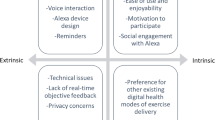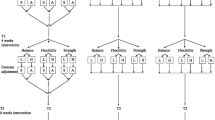Abstract
Objectives
To evaluate the feasibility of using voice-controlled intelligent personal assistants (VIPAs) to remotely deliver and monitor an individually-tailored, home-based exercise program to older adults living independently and alone.
Design
12-week, prospective single-arm feasibility study.
Setting
Community residences.
Participants
15 adults aged 60 to 89 years living alone.
Intervention
All participants were prescribed home-based muscle strengthening, weight-bearing impact and balance exercises, increasing from two to four 10-minute sessions per day over 12 weeks. Sessions were delivered using VIPAs (Amazon Alexa Echo Show 5; “Alexa”) and a novel software program (“Buddy Link”). The program was individualized by an exercise physiologist based on participant voice responses to Alexa questions.
Measurements
Study outcomes were feasibility (rate of retention, adherence, and adverse events), usability (System Usability Scale) and changes to quality of life (European Quality of Life Scale), and lower-extremity function (30 second sit-to-stand test).
Results
All 15 participants (mean age, 70.3 years) completed the study (retention 100%). Mean adherence to the exercise program was 115% (i.e., collectively all participants were prescribed 8640 exercises but completed 9944 exercises) with no adverse events reported to be related to the intervention and usability scored as above average (75/100). Other outcomes did not significantly change across the 12-week follow-up (all P>0.05).
Conclusions
In this feasibility study of community-dwelling older adults living alone, a home-based exercise program delivered and monitored remotely by an exercise physiologist using VIPAs was safe and feasible.



Similar content being viewed by others
References
Moore G, Durstine JL, Painter P, Medicine ACoS. Acsm’s exercise management for persons with chronic diseases and disabilities, 4E: Human Kinetics, 2016.
Jansons P, Robins L, O’Brien L, Haines T. Gym-based exercise and home-based exercise with telephone support have similar outcomes when used as maintenance programs in adults with chronic health conditions: a randomised trial. Journal of physiotherapy. 2017;63: 154–160. doi:https://doi.org/10.1016/j.jphys.2017.05.018
Barbabella F, Melchiorre MG, Quattrini S, et al. How can eHealth improve care for people with multimorbidity in Europe?: World Health Organization, Regional Office for Europe Copenhagen, 2017.
Kim BY, Lee J. Smart devices for older adults managing chronic disease: a scoping review. JMIR mHealth and uHealth. 2017;5: e7141. doi:https://doi.org/10.2196/mhealth.7141
Rush KL, Howlett L, Munro A, Burton L. Videoconference compared to telephone in healthcare delivery: a systematic review. International journal of medical informatics. 2018;118: 44–53. doi:https://doi.org/10.1016/j.ijmedinf.2018.07.007
Baillot A, Boissy P, Tousignant M, Langlois M-F. Feasibility and effect of in-home physical exercise training delivered via telehealth before bariatric surgery. Journal of telemedicine and telecare. 2017;23: 529–535. doi:https://doi.org/10.1177/1357633X16653511
Dixon RF, Rao L. Asynchronous virtual visits for the follow-up of chronic conditions. Telemedicine and e-Health. 2014;20: 669–672. doi:https://doi.org/10.1089/tmj.2013.0211
Chambers R, Beaney P. The potential of placing a digital assistant in patients’ homes. British Journal of General Practice, 2020. doi:https://doi.org/10.3399/bjgp20X707273
Norton K, Norton L. Pre-exercise screening. Guide to the Australian adult pre-exercise screening system exercise and sports science Australia. 2011.
Daly RM, Gianoudis J, Kersh ME, et al. Effects of a 12-month supervised, community-based, multimodal exercise program followed by a 6-month research-to-practice transition on bone mineral density, trabecular microarchitecture, and physical function in older adults: a randomized controlled trial. Journal of Bone and Mineral Research. 2020;35: 419–429. doi:https://doi.org/10.1002/jbmr.3865
Gale J. The Health Coaching Australia (HCA) model: an integrated model of health behaviour change for chronic disease prevention and chronic condition self-management. Health coaching guide for health practitioners: Using the HCA model of health coaching. 2010.
Rabin R, Charro Fd. EQ-SD: a measure of health status from the EuroQol Group. Annals of medicine. 2001;33: 337–343. doi:https://doi.org/10.3109/07853890109002087
Bohannon RW. Sit-to-stand test for measuring performance of lower extremity muscles. Perceptual and motor skills. 1995;80: 163–166. doi:https://doi.org/10.2466/pms.1995.80.1.163
Bangor A. An Empirical Evaluation of the System Usability Scale Usability Scale. vol, 2008. doi:https://doi.org/10.1080/10447310802205776
Luo Y, Lee B, Choe EK. TandemTrack: Shaping Consistent Exercise Experience by Complementing a Mobile App with a Smart Speaker. Proceedings of the 2020 CHI Conference on Human Factors in Computing Systems, 2020, pp. 1–13.
Silveira P, Van De Langenberg R, van Het Reve E, Daniel F, Casati F, De Bruin ED. Tablet-based strength-balance training to motivate and improve adherence to exercise in independently living older people: a phase II preclinical exploratory trial. Journal of medical Internet research. 2013;15: e159. doi:https://doi.org/10.2196/jmir.2579
Geraedts HA, Zijlstra W, Zhang W, et al. A home-based exercise program driven by tablet application and mobility monitoring for frail older adults: feasibility and practical implications. Preventing chronic disease. 2017;14: E12. doi:https://doi.org/10.5888/pcd14.160227externalicon.
Nikitina S, Didino D, Baez M, Casati F. Feasibility of virtual tablet-based group exercise among older adults in Siberia: Findings from two pilot trials. JMIR mHealth and uHealth. 2018;6: e40. doi:https://doi.org/10.2196/mhealth.7531
Daly RM, Gianoudis J, Hall T, Mundell NL, Maddison R. Feasibility, Usability, and Enjoyment of a Home-Based Exercise Program Delivered via an Exercise App for Musculoskeletal Health in Community-Dwelling Older Adults: Short-term Prospective Pilot Study. JMIR mHealth and uHealth. 2021;9: e21094. doi:https://doi.org/10.2196/21094
O’Brien K, Liggett A, Ramirez-Zohfeld V, Sunkara P, Lindquist LA. Voice-Controlled Intelligent Personal Assistants to Support Aging in Place. Journal of the American Geriatrics Society. 2020;68: 176–179. doi:https://doi.org/10.1111/jgs.16217
Perkin OJ, McGuigan PM, Stokes KA. Exercise snacking to improve muscle function in healthy older adults: a pilot study. Journal of aging research. 2019;2019. Doi:https://doi.org/10.1155/2019/7516939
Kwon S, Perera S, Pahor M, et al. What is a meaningful change in physical performance? Findings from a clinical trial in older adults (the LIFE-P study). JNHA-The Journal of Nutrition, Health and Aging. 2009;13: 538–544. https://doi.org/10.1007/s12603-009-0104-z.
Funding
Funding: DS is supported by an Australian National Health and Medical Research Council (NHMRC) RD Wright Biomedical Career Development Fellowship (GNT1123014) and an NHMRC Investigator Grant (GNT1174886). The study was supported by a Deakin University Institute for Physical Activity and Nutrition Seed Grant.
Author information
Authors and Affiliations
Contributions
Author Contributions: Study design by PJ, JD, EG RD, JF and DS. PJ drafted the manuscript and conducted the statistical analysis. JD, EG RD, JF, and DS were responsible for manuscript revision and preparation of this review. All authors have read and approved the manuscript.
Corresponding author
Ethics declarations
Conflicts of Interest: Eugene Gvozdenko is an director (unpaid position) of Great Australian Pty. Ltd. Great Australian Pty Ltd provided in-kind technical support for software and has non-financial interest in development of a voice-based virtual assistant software for telehealth. Deakin University provided competitive funding to support study.
Ethical standard: This study was approved by the Deakin University Human Research Ethics Committee (HREC 2020-166).
Rights and permissions
About this article
Cite this article
Jansons, P., Dalla Via, J., Daly, R.M. et al. Delivery of Home-Based Exercise Interventions in Older Adults Facilitated by Amazon Alexa: A 12-week Feasibility Trial. J Nutr Health Aging 26, 96–102 (2022). https://doi.org/10.1007/s12603-021-1717-0
Received:
Accepted:
Published:
Issue Date:
DOI: https://doi.org/10.1007/s12603-021-1717-0




